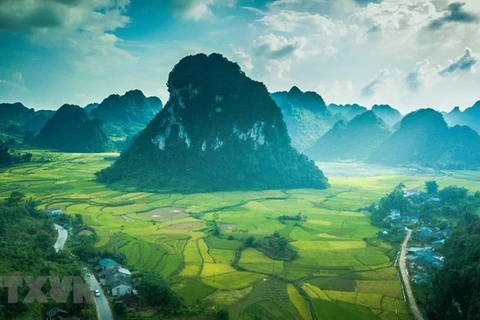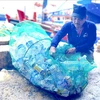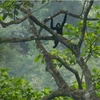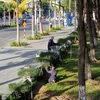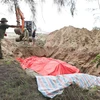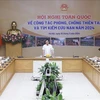Hanoi (VNA) - Minister of Natural Resources and Environment Tran Hong Ha on January 18 signed a decision announcing the top 10 events of the sector last year. Below are the selected events.
1. The 14th National Assembly approved the revised Law on Environmental Protection.
With 16 chapters and 171 articles, the revised law marks the first time a resident community has been defined as a subject in environmental protection. It also regulates environmental audits, the management and handling of waste to develop a circular economy, climate change response, the development of a domestic carbon market, and the conservation of natural heritages in line with international law, among others. The law will take effect from January 1, 2022.
2. Unusual and extreme natural disasters took place across three regions.
Hail and thunderstorms rained down violently on many northern provinces from the outset of the Lunar New Year 2020. The dry season saw a serious water shortage in the Mekong Delta, with early and deep saline intrusion for several days, exceeding the record set in 2016.
In the wet season, central provinces suffered from a series of consecutive and intense natural disasters. Within 42 days, they bore the brunt of six storms and one tropical depression, including a storm considered one of the two most intense in the last two decades. Meanwhile, rain-induced storms, floods, and landslides cost the region serious human and asset damage, with millions of local residents severely affected.
3. The sector integrated and operated its e-government system.
The sector surpassed target set for the provision of tier-4 online public services. It also connected to the national public service portal as well as to the information centres of the Government and Prime Minister, among others.
4. Vietnam completed updating of National Determined Contribution (NDC).
Despite COVID-19 and a scarcity of resources, the country was among only a few to complete this task, making a commitment to increasing its contributions to climate change response.
5. Vietnam established a national steering committee to implement its strategy for sustainable maritime economic development by 2030 with a vision towards 2045.
The committee is an interdisciplinary agency that advises the Prime Minister on studying, directing, and resolving important and interdisciplinary tasks related to the sustainable development of Vietnam’s marine economy.
6. The Dak Nong Geopark in the Central Highlands province of the same name became a member of the UNESCO Global Geoparks Network, while the Thai Thuy and Tam Giang - Cau Hai wetland nature reserves were established in the northern province of Thai Binh and the central province of Thua Thien Hue, respectively.
The Dak Nong Geopark covers more than 4,760 sq.km of land in six of the eight district-level localities in Dak Nong province. It is home to 118 heritage and geomorphological sites and nearly 50 caves with a total length of over 10,000 metres.
The establishment of the two wetland nature reserves was in line with the law on biodiversity, affirming Vietnam’s commitment to international treaties on the matter.
7. A pact was signed to launch the Vietnam National Plastic Action Partnership and a programme on mitigating marine plastic debris in Vietnam.
Signatories to the pact were the Ministry of Natural Resources and Environment and the World Economic Forum.
8. Vietnamese and Cambodian officials exchanged topographic border maps at 1:25,000 scale. The map shows the results of border delimitation and marker planting with 2,047 border markers installed.
Both sides held a ceremony to exchange a document approving the validity of the supplementary treaty to the 1985 Treaty on the Delimitation of National Boundaries and the 2005 Supplementary Treaty, and the Vietnam-Cambodia land border demarcation protocol.
9. The first phase of a governmental programme on searching for underground water resources to supply mountainous areas and regions facing shortages of water was completed.
The phase built 454 facilities and prepared conditions for the construction of 189 water supply stations in 36 cities and provinces. In the 2020 dry season, it handed over 13 facilities offering free clean water in nine provinces in the Mekong Delta and the Central Highlands regions.
10. The national science and technology programme on climate change response and the management of natural resources and environment for 2016-2020 saw significant results.
Several works were registered for intellectual property protection under the programme, while 233 articles, including 77 with an ISI or Scopus index, were published. It also helped improve the capacity of the sector’s human resources via the provision of training to turn out 1,844 masters, 980 doctorate holders, 186 associate professors, and 38 professors./.
1. The 14th National Assembly approved the revised Law on Environmental Protection.
With 16 chapters and 171 articles, the revised law marks the first time a resident community has been defined as a subject in environmental protection. It also regulates environmental audits, the management and handling of waste to develop a circular economy, climate change response, the development of a domestic carbon market, and the conservation of natural heritages in line with international law, among others. The law will take effect from January 1, 2022.
2. Unusual and extreme natural disasters took place across three regions.
Hail and thunderstorms rained down violently on many northern provinces from the outset of the Lunar New Year 2020. The dry season saw a serious water shortage in the Mekong Delta, with early and deep saline intrusion for several days, exceeding the record set in 2016.
In the wet season, central provinces suffered from a series of consecutive and intense natural disasters. Within 42 days, they bore the brunt of six storms and one tropical depression, including a storm considered one of the two most intense in the last two decades. Meanwhile, rain-induced storms, floods, and landslides cost the region serious human and asset damage, with millions of local residents severely affected.
3. The sector integrated and operated its e-government system.
The sector surpassed target set for the provision of tier-4 online public services. It also connected to the national public service portal as well as to the information centres of the Government and Prime Minister, among others.
4. Vietnam completed updating of National Determined Contribution (NDC).
Despite COVID-19 and a scarcity of resources, the country was among only a few to complete this task, making a commitment to increasing its contributions to climate change response.
5. Vietnam established a national steering committee to implement its strategy for sustainable maritime economic development by 2030 with a vision towards 2045.
The committee is an interdisciplinary agency that advises the Prime Minister on studying, directing, and resolving important and interdisciplinary tasks related to the sustainable development of Vietnam’s marine economy.
6. The Dak Nong Geopark in the Central Highlands province of the same name became a member of the UNESCO Global Geoparks Network, while the Thai Thuy and Tam Giang - Cau Hai wetland nature reserves were established in the northern province of Thai Binh and the central province of Thua Thien Hue, respectively.
The Dak Nong Geopark covers more than 4,760 sq.km of land in six of the eight district-level localities in Dak Nong province. It is home to 118 heritage and geomorphological sites and nearly 50 caves with a total length of over 10,000 metres.
The establishment of the two wetland nature reserves was in line with the law on biodiversity, affirming Vietnam’s commitment to international treaties on the matter.
7. A pact was signed to launch the Vietnam National Plastic Action Partnership and a programme on mitigating marine plastic debris in Vietnam.
Signatories to the pact were the Ministry of Natural Resources and Environment and the World Economic Forum.
8. Vietnamese and Cambodian officials exchanged topographic border maps at 1:25,000 scale. The map shows the results of border delimitation and marker planting with 2,047 border markers installed.
Both sides held a ceremony to exchange a document approving the validity of the supplementary treaty to the 1985 Treaty on the Delimitation of National Boundaries and the 2005 Supplementary Treaty, and the Vietnam-Cambodia land border demarcation protocol.
9. The first phase of a governmental programme on searching for underground water resources to supply mountainous areas and regions facing shortages of water was completed.
The phase built 454 facilities and prepared conditions for the construction of 189 water supply stations in 36 cities and provinces. In the 2020 dry season, it handed over 13 facilities offering free clean water in nine provinces in the Mekong Delta and the Central Highlands regions.
10. The national science and technology programme on climate change response and the management of natural resources and environment for 2016-2020 saw significant results.
Several works were registered for intellectual property protection under the programme, while 233 articles, including 77 with an ISI or Scopus index, were published. It also helped improve the capacity of the sector’s human resources via the provision of training to turn out 1,844 masters, 980 doctorate holders, 186 associate professors, and 38 professors./.
VNA







